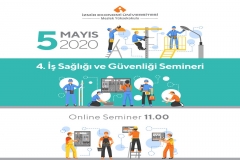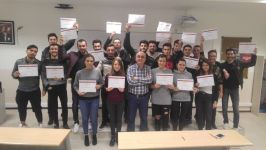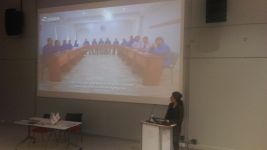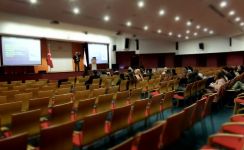
VOCATIONAL SCHOOL
Department of Occupational Health and Safety (Turkish)
RTV 140 | Course Introduction and Application Information
| Course Name |
Basic Knowledge of Communication
|
|
Code
|
Semester
|
Theory
(hour/week) |
Application/Lab
(hour/week) |
Local Credits
|
ECTS
|
|
RTV 140
|
Fall
|
3
|
0
|
3
|
5
|
| Prerequisites |
None
|
|||||
| Course Language |
Turkish
|
|||||
| Course Type |
Required
|
|||||
| Course Level |
Short Cycle
|
|||||
| Mode of Delivery | - | |||||
| Teaching Methods and Techniques of the Course | DiscussionGroup WorkCase StudyQ&AGuest SpeakerLecture / Presentation | |||||
| Course Coordinator | - | |||||
| Course Lecturer(s) | ||||||
| Assistant(s) | - | |||||
| Course Objectives | The aim of this course is to emphasize the importance of communicating effectively while explaining the methods and forms of communication. Students will gain knowledge about oral, written and non-verbal communication and they will learn main concepts of communication studies. |
| Learning Outcomes |
The students who succeeded in this course;
|
| Course Description | Definition, purpose and importance of communication, elements of communication process, forms of communication. |
|
|
Core Courses | |
| Major Area Courses | ||
| Supportive Courses | ||
| Media and Management Skills Courses | ||
| Transferable Skill Courses |
WEEKLY SUBJECTS AND RELATED PREPARATION STUDIES
| Week | Subjects | Related Preparation |
| 1 | The definition, purpose and importance of communication | Aysel Aziz, İletişime Giriş, Hiperlink, 4. Baskı: 2013. ISBN: 978-9944-157-14-8 Page: 25-36. |
| 2 | The definition, purpose and importance of communication | Nazife Güngör, İletişime Giriş, Siyasal Kitabevi, 3. Baskı: 2015. ISBN: 978-605-5782-59-7 Page: 19-41. |
| 3 | The communication process and its elements | Nazife Güngör, İletişime Giriş, Siyasal Kitabevi, 3. Baskı: 2015. ISBN: 978-605-5782-59-7 Page: 19-41. |
| 4 | The communication process and its elements | Aysel Aziz, İletişime Giriş, Hiperlink, 4. Baskı: 2013. ISBN: 978-9944-157-14-8 Page: 25-41. Nazife Güngör, İletişime Giriş, Siyasal Kitabevi, 3. Baskı: 2015. ISBN: 978-605-5782-59-7 Page: 19-41. |
| 5 | Face-to-face communication, using communication tools, formal/informal communication, audio/visual communication | Aysel Aziz, İletişime Giriş, Hiperlink, 4. Baskı: 2013. ISBN: 978-9944-157-14-8 Page: 55-57. Nazife Güngör, İletişime Giriş, Siyasal Kitabevi, 3. Baskı: 2015. ISBN: 978-605-5782-59-7 Page: 78-106. |
| 6 | Written communication | 6- Nazife Güngör, İletişime Kuram Yaklaşımlar, Siyasal Kitabevi, 2. Baskı: 2013. ISBN: 978-605-5782-59-9 Page: 37-53. Nazife Güngör, İletişime Giriş, Siayasal Kitabevi, 3. Baskı: 2015. ISBN: 978-605-5782-59-7 Page: 78-106. Aysel Aziz, İletişime Giriş, Hiperlink, 4. Baskı: 2013. ISBN: 978-9944-157-14-8 Page: 51-57. |
| 7 | Verbal communication | Nazife Güngör, İletişime Giriş, Siyasal Kitabevi, 3. Baskı: 2015. ISBN: 978-605-5782-59-7 Page: 139-180. Aysel Aziz, İletişime Giriş, Hiperlink, 4. Baskı: 2013. ISBN: 978-9944-157-14-8 Page: 57-59. |
| 8 | Non-verbal communication | Nazife Güngör, İletişime Giriş, Siyasal Kitabevi, 3. Baskı: 2015. ISBN: 978-605-5782-59-7 Page: 180-197 / 210- 251. Aysel Aziz, İletişime Giriş, Hiperlink, 4. Baskı: 2013. ISBN: 978-9944-157-14-8 Page: 59/ 113- 135. |
| 9 | Midterm Exam | |
| 10 | Intrapersonal communication | Nazife Güngör, İletişime Giriş, Siyasal Kitabevi, 3. Baskı: 2015. ISBN: 978-605-5782-59-7 Page: 139-180. Aysel Aziz, İletişime Giriş, Hiperlink, 4. Baskı: 2013. ISBN: 978-9944-157-14-8 Page: 57-59. |
| 11 | Interpersonal communication | Nazife Güngör, İletişime Giriş, Siyasal Kitabevi, 3. Baskı: 2015. ISBN: 978-605-5782-59-7 Page: 139-180. Aysel Aziz, İletişime Giriş, Hiperlink, 4. Baskı: 2013. ISBN: 978-9944-157-14-8 Page: 57-59. |
| 12 | Group communication, mass communication | Nazife Güngör, İletişime Giriş, Siyasal Kitabevi, 3. Baskı: 2015. ISBN: 978-605-5782-59-7 Page: 180-197 / 210- 251. Aysel Aziz, İletişime Giriş, Hiperlink, 4. Baskı: 2013. ISBN: 978-9944-157-14-8 Page: 59/ 113- 135. |
| 13 | Corporate communication | Nazife Güngör, İletişime Giriş, Siyasal Kitabevi, 3. Baskı: 2015. ISBN: 978-605-5782-59-7 Page: 269- 303. Aysel Aziz, İletişime Giriş, Hiperlink, 4. Baskı: 2013. ISBN: 978-9944-157-14-8 Page: 60-63. |
| 14 | Intercultural communication | Nazife Güngör, İletişime Giriş, Siyasal Kitabevi, 3. Baskı: 2015. ISBN: 978-605-5782-59-7 Page: 269- 303. Aysel Aziz, İletişime Giriş, Hiperlink, 4. Baskı: 2013. ISBN: 978-9944-157-14-8 Page: 60-63. |
| 15 | Review of the semester | |
| 16 | Final Exam |
| Course Notes/Textbooks | Güngör, Nazife, İletişime Giriş. Ankara : Siyasal Kitabevi, 3. Baskı: 2015. ISBN: 978-605-5782-59-7. Aziz, Aysel, İletişime Giriş. İstanbul : Hiperlink, 4. Baskı: 2013.ISBN: 978-9944-157-14-8 Güngör, Nazife, İletişime Kuram Yaklaşımlar, Siyasal Kitabevi, 2. Baskı: 2013. ISBN: 978-605-5782-59-9 |
| Suggested Readings/Materials | Kişilerarası İletişim Bilgiler Etkiler Engeller (Demet Gürüz, Ayşen Temel Eğinli) İletişim Becerileri Anlamak- Anlatmak- Anlaşmak (Demet Gürüz, Ayşen Temel Eğinli) |
EVALUATION SYSTEM
| Semester Activities | Number | Weigthing |
| Participation |
1
|
10
|
| Laboratory / Application | ||
| Field Work | ||
| Quizzes / Studio Critiques | ||
| Portfolio | ||
| Homework / Assignments | ||
| Presentation / Jury |
1
|
30
|
| Project | ||
| Seminar / Workshop | ||
| Oral Exams | ||
| Midterm |
1
|
25
|
| Final Exam |
1
|
35
|
| Total |
| Weighting of Semester Activities on the Final Grade |
4
|
65
|
| Weighting of End-of-Semester Activities on the Final Grade |
1
|
35
|
| Total |
ECTS / WORKLOAD TABLE
| Semester Activities | Number | Duration (Hours) | Workload |
|---|---|---|---|
| Theoretical Course Hours (Including exam week: 16 x total hours) |
16
|
3
|
48
|
| Laboratory / Application Hours (Including exam week: '.16.' x total hours) |
16
|
0
|
|
| Study Hours Out of Class |
14
|
3
|
42
|
| Field Work |
0
|
||
| Quizzes / Studio Critiques |
0
|
||
| Portfolio |
0
|
||
| Homework / Assignments |
0
|
||
| Presentation / Jury |
1
|
18
|
18
|
| Project |
0
|
||
| Seminar / Workshop |
0
|
||
| Oral Exam |
0
|
||
| Midterms |
1
|
14
|
14
|
| Final Exam |
1
|
22
|
22
|
| Total |
144
|
COURSE LEARNING OUTCOMES AND PROGRAM QUALIFICATIONS RELATIONSHIP
|
#
|
Program Competencies/Outcomes |
* Contribution Level
|
||||
|
1
|
2
|
3
|
4
|
5
|
||
| 1 | To have information about the concepts, methods and tools that constitute the basis of occupational health and safety. |
X | ||||
| 2 | To be able to follow, interpret and apply legal regulations on occupational health and safety. |
X | ||||
| 3 | To have knowledge about the dangers of chemicals and to make risk assessment. |
X | ||||
| 4 | To be able to identify the hazards and risks in mining operations. |
X | ||||
| 5 | To have knowledge about machines, equipment and protectors. |
X | ||||
| 6 | To be able to organize fire fighting process as a knowledge of fire protection. |
X | ||||
| 7 | To have knowledge about personal protectors and equipments. |
X | ||||
| 8 | To have the consciousness of professional and ethical responsibility and has the basic legal concepts required by the profession. |
X | ||||
| 9 | To have information about occupational accidents and occupational diseases, to identify, record and report hazards and risks in the workplace., |
X | ||||
| 10 | To be able to follow the information in the field and communicate with colleagues by using English at the general level of European Language Portfolio A2. |
X | ||||
| 11 | To be able to organize occupational health and safety trainings by doing business planning and organization. |
X | ||||
| 12 | To be able to work effectively in individual and multi-disciplinary teams and to be able to use them in working environment. |
X | ||||
| 13 | To be able to direct his/her education to a further level of education. |
X | ||||
*1 Lowest, 2 Low, 3 Average, 4 High, 5 Highest








